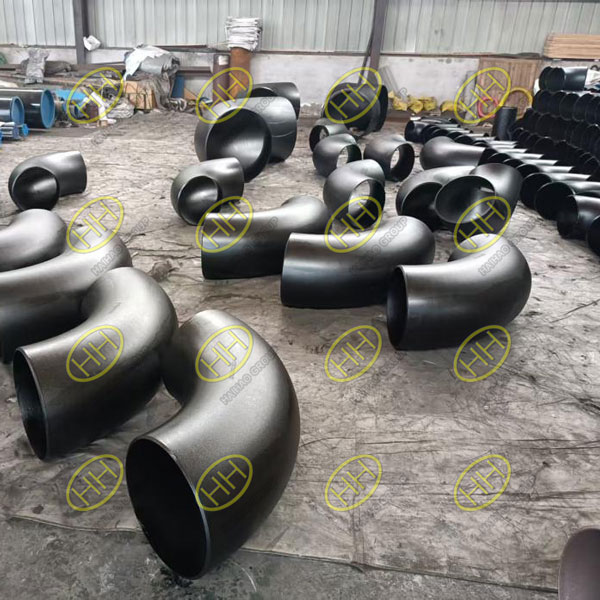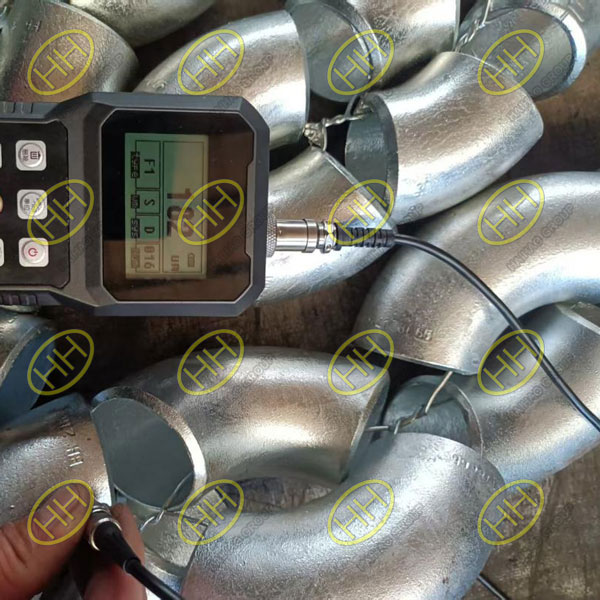ASME B16.9 Pipe Fittings A234 WPB vs. A420 WPL6 – Choosing the Right Material for Critical Pipeline Performance
In the complex world of industrial piping, selecting the correct material for pipe fittings isn’t just about functionality—it’s paramount for pipeline integrity, safety, and long-term operational efficiency. Recently, Haihao Group delivered ASME B16.9 pipe fittings to Australian customers, including ASTM A234 WPB and ASTM A420 WPL6.While both are robust carbon steel grades, their distinct metallurgical properties and temperature suitability mean choosing the wrong one could lead to catastrophic failure.
This comprehensive guide will dive into the fundamental differences between A234 WPB and A420 WPL6, illustrating their specific applications and demonstrating how Haihao Group helps global clients make precise material selections for demanding pipeline systems.
1.What is ASTM A234 WPB?
ASTM A234 WPB is the most common and versatile specification for wrought carbon steel and alloy steel fittings used in moderate and high-temperature service pressure piping and pressure vessel applications. The “WP” stands for wrought pipe, and “B” denotes a specific grade of carbon steel.
Key Characteristics of A234 WPB Fittings:
General Purpose: It’s the go-to choice for a vast majority of industrial pipeline applications where operating temperatures are above freezing and below very high heat.
Moderate Temperature Suitability: Designed for service temperatures ranging from approximately -20°F (-29°C) up to 800°F (427°C), depending on specific design codes.
Good Weldability & Formability: Its chemical composition (primarily carbon, manganese, phosphorus, sulfur, and silicon) allows for excellent weldability and ease of fabrication.
Strength: It offers a minimum tensile strength of 60,000 psi (415 MPa) and a minimum yield strength of 35,000 psi (240 MPa).
2.What is ASTM A420 WPL6?
ASTM A420 WPL6 is specifically engineered for low-temperature service applications. The “WP” again stands for wrought pipe, and “L6” denotes a specific grade for low-temperature use, distinguishing it from general-purpose carbon steel.
Key Characteristics of A420 WPL6 Fittings:
Cryogenic & Low-Temperature Service:Its primary purpose is in applications where temperatures can drop significantly, as low as -50°F (-46°C). This is crucial for preventing brittle fracture in extremely cold environments.
Superior Impact Toughness:To withstand cold temperatures without becoming brittle, A420 WPL6 fittings undergo rigorous Charpy V-notch impact testing at specified low temperatures (-46°C for WPL6) to ensure they retain sufficient ductility and toughness.
Chemical Composition:Contains carefully controlled levels of carbon, manganese, nickel, and other elements to ensure its low-temperature properties.
Higher Strength:Typically offers a minimum tensile strength of 70,000 psi (485 MPa) and a minimum yield strength of 40,000 psi (275 MPa), generally higher than A234 WPB.
3.A234 WPB vs. A420 WPL6: A Direct Comparison
Understanding the fundamental differences is key to proper material selection for pipeline integrity.
| Property | ASTM A234 WPB | ASTM A420 WPL6 |
| Primary Use | Moderate to high-temperature service | Low-temperature / Cryogenic service |
| Temperature Grade | -20°F to 800°F (-29°C to 427°C) (approx.) | As low as -50°F (-46°C) |
| Tensile Strength | ≥ 60,000 psi (415 MPa) | ≥ 70,000 psi (485 MPa) |
| Yield Strength | ≥ 35,000 psi (240 MPa) | ≥ 40,000 psi (275 MPa) |
| Impact Testing | Not typically required for standard use | Required at -50°F (-46°C) (Charpy V-notch) |
| Key Property | Strength & Formability at moderate temps | Impact Toughness at low temps, preventing brittle fracture |
| Typical Color Coding | Black or Red (often no specific standard) | Light Blue (industry standard for LT fittings) |
| Primary Applications | Refineries, power plants, general industrial, water systems | LNG facilities, cryogenic systems, subsea pipelines, refrigeration units |
4.Choosing the Right Material: Matching Fittings to Operational Demands
Selecting the correct material for your ASME B16.9 fittings is a critical engineering decision that directly impacts the safety and longevity of your pipeline system. Incorrect material selection can lead to devastating failures, especially in environments where temperature fluctuations or extreme cold are factors.
4.1.Choose ASTM A234 WPB Fittings for:
General industrial pipelines where operating temperatures are moderate and do not drop below typical ambient freezing points.
Above-ground oil & gas networks not exposed to cryogenic processes or severe arctic conditions.
Steam and hot water systems where elevated temperatures are the primary concern.
Refineries, chemical plants, and general utility pipelines.
4.2.Choose ASTM A420 WPL6 Fittings for:
Cryogenic or refrigerated pipelines: Essential for transporting liquefied gases like LNG (Liquefied Natural Gas), LPG, or industrial gases like oxygen and nitrogen.
Subsea pipelines: Where consistently low ambient seabed temperatures demand guaranteed impact toughness.
LNG processing and storage facilities: All associated piping and fittings must maintain ductility at very low temperatures.
Pipelines in extremely cold climates (e.g., Arctic regions).
5.Why Partner with Haihao Group for Your Pipe Fittings?
Choosing the right supplier for ASME B16.9 pipe fittings is as critical as selecting the right material. Haihao Group stands as a trusted partner, combining extensive experience with a relentless commitment to quality and customer service.
Global Experience & Reliability:With over 40 years of export experience, we possess an in-depth understanding of international project requirements, logistics, and regional standards, ensuring seamless global delivery.
Comprehensive Product Range:We offer a full range of ASME B16.9 fittings in various materials, including carbon steel (A234 WPB, A420 WPL6), alloy steel, and stainless steel, catering to virtually any piping application.
Unwavering Quality Assurance:Our certified quality management system (ISO 9001, PED, CE) is backed by an in-house advanced testing laboratory. We perform rigorous inspections including Positive Material Identification (PMI), Ultrasonic Testing (UT), X-ray inspection, Hydrostatic Testing, and crucial Charpy Impact Testing, providing detailed MTC 3.1 certificates for complete material traceability.
Customization & Technical Support:Our technical team provides expert assistance in material selection, offering customized dimensions and wall thicknesses to meet unique project specifications and optimize performance.
Global Reach & References:We have a proven track record of successful projects and satisfied clients across Australia, Europe, the Middle East, and beyond.
Contact Haihao Group today for expert technical support or a quick quotation tailored to your project’s precise requirements.


